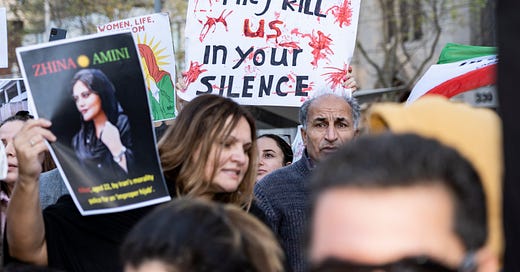Assembly, Collective Action, and Power
Governments are well aware that groups are more powerful than individuals

Last week, I traveled to Austin for a dialogue with University of Texas Law Dean Bobby Chesney titled “Revisiting the Right of Assembly,” sponsored by the Bech-Loughlin First Amendment Center. In addition to leading one of the nation’s top law schools, Dean Chesney is an expert on national security law and the founding director of the Robert S. Strauss Center for International Security and Law.
Part of our dialogue highlighted the intersection of my work on the right of assembly and Dean Chesney’s national security expertise. One particular thread that stood out to me focused on assembly as a form of collective action that can threaten governmental power.
In the News
The threat of assembly to governmental power is never far from the headlines. Earlier this month, NPR reported on Iranians who have been protesting their government since September. As NPR notes:
The protests, frequently led by women, broke out in northwestern Iran following the death of a young Kurdish woman, 22-year-old Mahsa Amini—known by her Kurdish name, Jina, to family and friends—in the custody of Iran's co-called “morality police.” Demonstrations quickly spread across the country, and soon transformed from protesting the mandatory Islamic headscarf, the hijab, to calling for the end of Iran’s cleric-led regime.
The government response has been swift and brutal, with shootings of protesters on the streets, thousands of arrests, and two executions. NPR also noted ominously that it connected with protesters “despite Tehran’s efforts to curtail internet access and other means of communication.”
Iran’s response to political assemblies is particularly violent and egregious, but it is not the only country attempting to impose assembly limits. This past week, Britain considered a public order bill that purportedly gives police in England and Wales “powers to shut down protests before any disruption” and aims to curtail tactics like “slow marching.” The Guardian reports that the bill will also “place restrictions on individual activists and [allow] new stop and search powers for protest.”
Nor is the United States free of such challenges. As I noted in an earlier post, our country has no shortage of examples of unconstitutional restrictions on peaceful protests.
In My Head
The political power of collective action has long been of concern to governmental actors. As Dean Chesney noted during our dialogue, at the time of the American Founding:
There was a great deal of controversy that surrounded things we take for granted about the propriety of ordinary people getting together to discuss political matters. . . . The people in power understood the importance of controlling the way that information flowed.
In that “less technologically advanced society,” Chesney noted, significant power came from “assembly—just being together.”
In response to Chesney’s comment, I made two other observations about power. I first noted that people acting collectively are often more powerful than people acting individually:
Management will not often listen to a single employee but will listen to a labor strike. Consumer boycotts by one person usually don’t go as well as when you can aggregate them. Protests work better with more people—even petitioning can aggregate. The collective nature is a form of power.
I then suggested that these forms of power often unfold in very informal settings:
Think about the importance of the tavern or the pub during the time of the Revolution. [Ideas of democratic sovereignty] didn’t emerge through some formal congressional debate hall—it was over beers in a tavern. It was in coffee houses—then and now—the Ferguson protestors organized in coffee houses. When we think about protecting the boundaries of assembly as a form of democratic sovereignty, as a way of people to identify and grow power, we have to be thinking about the informal spaces as well as the formal ones.
You can watch our entire dialogue here:
In the World
I first came across Dean Chesney’s work when I was a graduate student working on my dissertation about the right of assembly. His 2004 article, “Democratic-Republican Societies, Subversion, and the Limits of Legitimate Political Dissent in the Early Republic,” remains one of the best considerations of the ways these early societies claimed associational rights against charges of sedition and dissent.
Chesney’s article notes that the Democratic-Republican societies “embodied an understanding of popular sovereignty and representation in which the role of the citizen was not limited to periodic voting, but instead entailed active and constant engagement in political life.” This “active and constant engagement” points to an ongoing form of assembly that transcends periodic protests or gatherings.
Chesney also recounts how President Washington took aim at the Democratic-Republican societies in his annual address to Congress in 1794, asserting that “associations of men” and “certain self-created societies” had fostered the Whiskey Rebellion. Chesney suggests that “the speech was widely understood at the time not as ordinary political criticism, but instead as a denial of the legality of organized and sustained political dissent.”
As I note in Liberty’s Refuge: The Forgotten Freedom of Assembly, the responses to Washington’s criticism represent some of the earliest popular claims to the right of assembly in the newly formed nation. Addressing Washington’s charge that the societies were “self-created,” the Democratic Society of New York asked: “Is it for assembling, that we are accused; what law forbids it?”
The Patriotic Society of the County of New Castle noted more tersely: “The right of the people to assemble and consult for their common good, has been questioned by some; to such we disdain any reply.”
Today, a similar resolve unfolds on the streets of Tehran and in other parts of the world.




